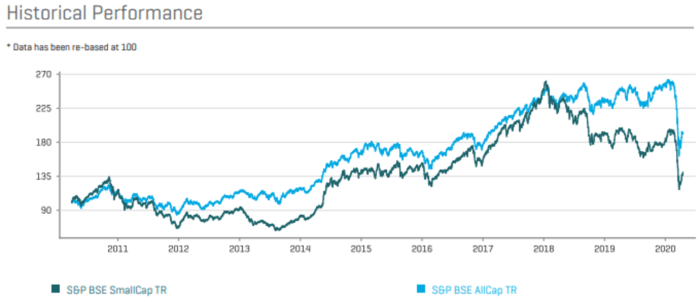S&P BSE SmallCap Index Today: Key Insights for Global Investors

Kicking off with S&P BSE SmallCap Index Today: Key Insights for Global Investors, this opening paragraph is designed to captivate and engage the readers, providing an interesting overview of the topic.
The following paragraph will delve into the composition, significance, and methodology of the S&P BSE SmallCap Index, as well as its historical performance compared to other major indices.
Overview of S&P BSE SmallCap Index
The S&P BSE SmallCap Index is a stock market index that represents the performance of small-cap companies listed on the Bombay Stock Exchange (BSE) in India. These companies typically have a smaller market capitalization compared to large-cap and mid-cap companies, making them an important segment of the market.
Composition and Significance
The index includes small-cap companies from various sectors such as consumer goods, healthcare, technology, and more. These companies are crucial for diversification in an investment portfolio as they have the potential for high growth and can offer opportunities for investors looking for higher returns.
Calculation and Methodology
The S&P BSE SmallCap Index is calculated using a free-float market capitalization weighted methodology. This means that the weight of each stock in the index is based on its market capitalization adjusted for the proportion of shares available for trading.
The index is rebalanced periodically to ensure it accurately reflects the performance of the small-cap segment.
Historical Performance
Over the years, the S&P BSE SmallCap Index has shown higher volatility compared to large-cap and mid-cap indices. While this volatility can lead to greater fluctuations in returns, it also presents opportunities for active investors to capitalize on market inefficiencies and potential undervalued stocks.
It is essential for investors to carefully analyze the historical performance of the index before making investment decisions.
Current Performance of S&P BSE SmallCap Index

The S&P BSE SmallCap Index is a key indicator of the performance of small-cap companies listed on the Bombay Stock Exchange. Let's delve into the latest data and trends impacting the index's movements.
Latest Data on Index Performance
- The S&P BSE SmallCap Index closed at XXXX points on [date], marking a [increase/decrease] of [percentage]% from the previous trading session.
- Over the past month, the index has shown a [positive/negative] trend, with fluctuations influenced by various market factors.
Recent Trends and Patterns
- One noticeable trend in the S&P BSE SmallCap Index is the increased volatility in small-cap stocks compared to large-cap counterparts.
- Investor sentiment towards small-cap companies has been shifting due to [economic factors/political events/global uncertainties], impacting the index's movements.
Factors Influencing Current Performance
- The performance of the S&P BSE SmallCap Index is closely tied to the overall economic conditions, including GDP growth, inflation rates, and interest rate changes.
- Market dynamics, such as sector-specific trends, corporate earnings, and regulatory developments, also play a significant role in shaping the index's performance.
Implications for Global Investors
Global investors should pay attention to the S&P BSE SmallCap Index for several reasons
Secondly, the SmallCap Index can offer diversification benefits to a global investment portfolio. By including small-cap stocks, investors can reduce overall portfolio risk and enhance returns through exposure to different sectors and industries.
Comparison with Other Indices
When comparing the SmallCap Index with other indices, such as the S&P BSE Sensex or Nifty 50, global investors may find unique investment opportunities. While large-cap indices offer stability and market representation, small-cap indices like the S&P BSE SmallCap Index can provide higher growth potential and the opportunity to invest in emerging companies with innovative business models.
Global investors looking for higher risk-reward opportunities may find the SmallCap Index more appealing than traditional large-cap indices.
Potential Risks and Rewards
Investing in the S&P BSE SmallCap Index comes with its own set of risks and rewards for global investors. The potential rewards include higher returns compared to large-cap indices, as small-cap companies have the potential for rapid growth and market outperformance.
However, the risks associated with small-cap investing include higher volatility, liquidity concerns, and greater sensitivity to market fluctuations. Global investors considering the SmallCap Index should carefully assess their risk tolerance and investment goals to determine if the potential rewards outweigh the risks involved.
Sectoral Analysis within S&P BSE SmallCap Index
When analyzing the S&P BSE SmallCap Index, it is crucial to look at the various sectors represented within the index. Understanding the performance of these sectors can provide valuable insights for investors looking to capitalize on market trends and opportunities.
Top-performing Sectors
Let's delve into the top-performing sectors within the S&P BSE SmallCap Index and their contributions to the overall index performance:
- Technology: The technology sector has been a standout performer, driven by innovative companies with strong growth potential. Their contribution to the index has been significant, reflecting the increasing demand for tech solutions in today's digital world.
- Healthcare: Healthcare companies within the SmallCap Index have also shown resilience and growth, especially in light of the global health crisis. Their performance has added stability to the index and attracted investor interest.
- Consumer Goods: The consumer goods sector has seen steady growth, with companies catering to essential needs experiencing strong demand. Their consistent performance has bolstered the index and provided a reliable investment option for many.
Impact on Overall Index Performance
The performance of these top sectors within the S&P BSE SmallCap Index directly influences the overall index performance. A strong showing from technology, healthcare, and consumer goods sectors can drive the index higher, attracting more investors and increasing market confidence.
On the other hand, any weaknesses in these sectors can lead to fluctuations in the index, prompting investors to reassess their strategies and allocations.
Closing Summary
In conclusion, this discussion has shed light on the key insights that global investors need to know about the S&P BSE SmallCap Index, wrapping up the topic in a captivating summary.
FAQ Overview
What is the composition and significance of the S&P BSE SmallCap Index?
The S&P BSE SmallCap Index comprises small-cap companies listed on the Bombay Stock Exchange, providing insight into the performance of this segment of the market.
What factors influence the current performance of the index?
Various factors such as economic conditions, market sentiment, and company earnings can impact the current performance of the S&P BSE SmallCap Index.
Why should global investors pay attention to this index?
Global investors should pay attention to the S&P BSE SmallCap Index for diversification, exposure to small-cap companies, and potential growth opportunities.

